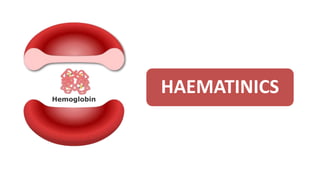
Hematinics
- 1. HAEMATINICS
- 2. Anemia Anemia is characterized by reduction in oxygen carrying capacity of blood. It is caused by four factors: •Decrease in the normal number of erythrocytes; •A decrease of normal amounts of hemoglobin in the RBCs; •A deficiency of normal hemoglobin; •Production of abnormal hemoglobin.
- 4. Anemia reduces the amount of oxygen that RBCs can transport resulting in a lack of energy, shortness of breath on minor exertions, exhaustion, increased heart rate, anorexia, pale skin, and a general feeling of tiredness.
- 7. WHAT DO YOU MEAN HEMATINICS? • Hematinics are the agents used for prevention and treatment of anemia’s. CLASSSIFICATION • Essential hematinic • Ex. Iron (ferrous sulphate, ferrous fumarate, ferrous gluconate), Folic acid, • Accessary hematinics • Ex. Vitamin B12 (Cyanocobalamine), Erythropoietin.
- 8. Iron-deficiency anemia • Iron-deficiency anemia results from nutritional deficiencies or from excessive iron loss from the body, resulting in lower than normal erythrocyte production. • It is most commonly observe in pregnancy because of deficiency of iron (Fe++) in Hb of RBCs. • Treatment: Iron compounds like ferrous sulphate, ferrous fumarate, ferrous gluconate etc
- 13. Sr. No. Type of anemia Treatment 1) Iron-deficiency anemia It is most commonly observe in pregnancy because of deficiency of iron (Fe++) in Hb of RBCs. Iron compounds like ferrous sulphate, ferrous fumarate, ferrous gluconate etc 1) Megaloblastic anemia It is characterized by deficiency of Vitamin B12 and folic acid which affect maturation of RBCs during erythropoiesis. Folic acid and vitamin B12 orally 1) Pernicious anemia it is characterized by lack of intrinsic factor which is essential for absorption of vitamin B12 (cyanocobalamine) in the stomach. Vitamin B12 injection intravenously 1) Aplastic anemia It is characterized by reduction in RBC count due to bone marrow failure Erythropoietin hormone, bone marrow transplant
- 15. 1) Hemolytic anemia Hemolytic anemia is a genetic inherited condition in which erythrocytes rupture or destroyed at a faster rate than normal. Blood transfusion 1) Thalassemia Thalassemia is a genetic inherited disease. There is reduced globin synthesis with reduced Hemoglobin production, leading to early hemolysis Blood transfusion 1) Hemorrhagic anemia Due to severe blood loss in injury, surgery, bleeding due to ulcer, piles and accidents Blood transfusion 1) Sickle cell anemia The erythrocytes have an abnormal sickle shape (S/C shaped) with abnormal hemoglobin. The life span is reduced due to early hemolysis. Blood transfusion 1) Macrocytic anemia Abnormally large size RBCs than normal size in blood Protein supplementation
- 16. Iron plays an important role as haematinic? •Erythropoiesis is the process of production of RBCs in the red bone marrow. •Hemoglobin is the important component of RBC which transports the oxygen and carbon dioxide. •Each molecule of Hemoglobin contains 4 iron (ferrous Fe++) and 1 globin portion. To be continued…..
- 17. To be continued….. •If there is deficiency of iron then Hemoglobin synthesis will be reduced. If Hemoglobin level reduced then RBC becomes small size and can’t transport O2 and CO2. •Hence, iron is the essential factor for erythropoiesis.
- 18. Vitamin B12 injection is given in pernicious anemia. • Pernicious anemia is characterized by lack of intrinsic factor which is essential for absorption of vitamin B12 (cyanocobalamine) in the stomach. • Vitamin B12 is essential for maturation for RBCs in erythropoiesis. • In Pernicious anemia, if vitamin B12 is given by oral route, its absorption will not occur. • Therefore Vitamin B12 injection is given in pernicious anemia.
